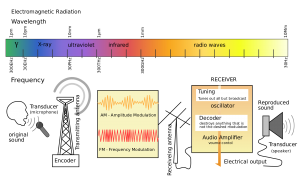With the most recent generations having primarily grown up on FM radio, there is an abundance of people who don’t realise the vastness to radio broadcasting like AM, FM, Pirate Radio, Terrestrial digital Radio, and Satellite. Here is a brief overview of the differing types of radio broadcasting:
AM: AM (amplitude modulation) was the earliest form of radio broadcasting. This specific type of broadcasting got it’s name for how it emits radio waves by manipulating the amplitude of the signal in conjunction with the amplitude of the signal that is being transmitted. What is known as a ‘medium-wave band’ is what is used worldwide to deliver AM broadcasting across the globe, while other parts of the world (like Europe) also use ‘long-wave band’ broadcasting. A great advantage to AM radio is that is fairly simplistic and the sound that is emitted from this type of signal can be easily detected.

FM: FM radio (frequency modulation) was invented in the 1930s as a way to counter the interference issues with AM radio. FM radio stations happen on VHF (very high frequency) waves and are much more common thanks to better sound fidelity, which allowed stereo broadcasting to thrive on this specific type of broadcasting network. FM ranges are much shorter than AM ranges, despite the high frequency, meaning that the FM radio is much better for local radio stations. When this technology was originally developed, there wasn’t a specific threat to AM radio because FM radio required people to purchase a different type of receiver. It wasn’t until after World War II that there was a change in frequencies that allowed FM radio to be more accessible, thus toppling the popularity of AM radio.
Pirate Radio: This type of radio refers to ‘illegal’ or un-regulated radio transmission. Often, this sort of radio broadcasting is used for political reasons, for entertainment, or as an exchange of two-way radio. While the origins of pirate radio can be linked to a general unlicenced use, history suggests that there have been moments that ships out at sea have used this mode of communication (ie pirate) as a base for broadcasting. While rules and regulations depend on where a person is at in the world, this type of broadcasting normally refers to an FM, AM, or short wave signal transmission. Even more interesting is that the origin of the broadcast may be legal, but where the broadcast is received may be construed as illegal (ie if a broadcast goes across borders)..
Terrestrial Digital Radio: Digital radio surfaced in the mid 1990’s in Europe, making its debut in the UK in ‘95, in Germany in ’99 and eventually emerging in the United States, France, Netherlands, and South Africa shortly after. A simpler term to describe this type of radio is DAB Digital Radio (Digital Audio Broadcasting). Digital radio is still an evolving form of radio that has a strong foothold in Europe, but is still lacking in a lot of countries (specifically in the US).
Satellite Radio: As the name suggests, this is a radio broadcasting service that is produced via satellites. Satellite radios are able to broadcast to a very large geographical area compared to all of its counterparts and was developed to be used primarily in cars. Most often, satellite radio is only available through a subscription, meaning it isn’t a free service. An interesting note about satellite stations is that ground stations often send signals to satellites that are in turn projected back to radio receivers in both cars and homes. This particular signal not only has scrambled broadcasts, but also retains meta-data regarding particular broadcasts. These signals have to be sorted by radio receivers that display the information. This type of technology allows for a radio station to be heard nation and worldwide.
